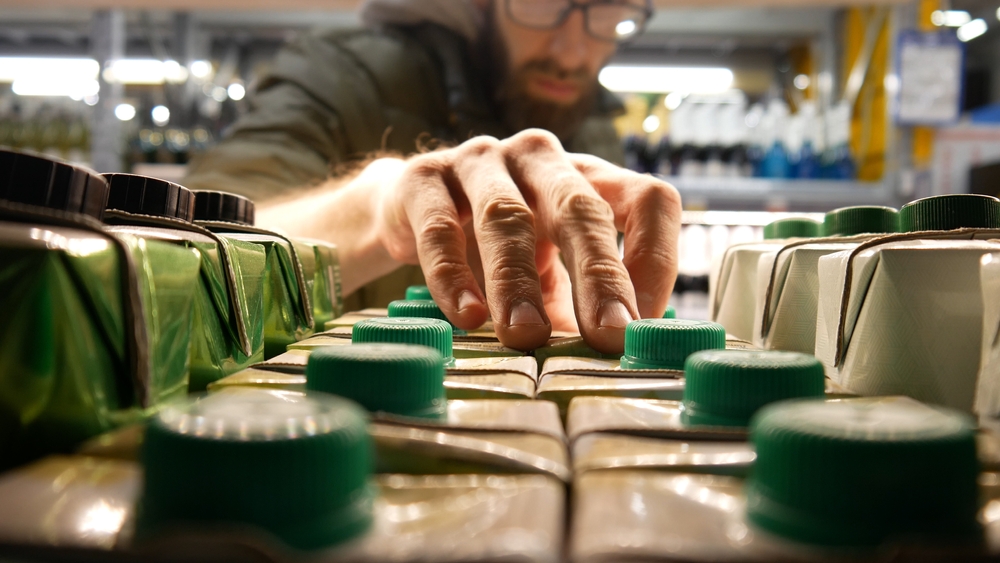The first part of the debate looked at the current situation while the second part looked ahead and featured a crucial address by the top European Commission packaging official, Otto Linher.
Stone: “not what industry wanted”
The meeting opened with a presentation from Michael Stone, former chairman of packaging lobbying and education group Incpen. Mr Stone who had a senior packaging role with David S Smith plc, said: “I controversially believe that the packaging industry regulations are not what industry wanted. They have much in common with the privatisation of the railways. They were born of political dogma, had no understanding of industry and were of unnecessary complexity.” He also noted that: “We have a system that cries out for common understanding, common objectives.”
At European level, said Mr Stone, disharmony rules “with each country adopting a different system, the danger of creating barriers to trade is a very real one. There is no incentive to put in a recycling plant here as there is in other countries where there is greater intervention.”
However, he conceded that the UK system is more cost-effective than other European schemes. But, said that “it is cheaper because it does not tackle the issue of domestic waste which is done here [the UK] by local authorities.”
Mr Stone advised that the UK system needed sympathetic management in at least three areas. One is to ensure that money goes into recycling and provides a climate of certainty for new investment. Two, to bring together different parties to promote common objectives, and three to integrate local government and industry thinking.
Mr Stone also claimed that the Office of Fair Trading (which wanted more than one compliance scheme because of fair trading concerns) are “authors of a great deal of our problems”.
Sheila McKinley: “look beyond 2001”
Sheila McKinley, who heads the producer responsibility unit within the Department of the Environment, Transport and the Regions spoke to give a less than 100% defence of the current system, admitting that some changes are on the cards. And, she emphasised the need to look beyond the 2001 targets to the next level in 2006.
Mrs McKinley gave three advantages to the UK system: – compliance with directive at low cost, at a lower compliance cost than in other member states and at around half of the cost of originally predicted – direct link between packaging handled and recycling and recovery obligations – re-used packaging only counted on the first trip and the obligation can be discharged over four years.
“We have a direct cost incentive on industry to think very hard about the amount of packaging they use,” the civil servant said.
She laid considerable emphasis on the need for more re-use in her speech, with the advantage that this approach puts less packaging into the waste stream.
Summarising the current situation, Mrs McKinley said that at November 2000 “the UK had reached a recovery rate of over 38% and a recycling rate of 33%. There were 17 compliance schemes and around 14,000 covered by registration.”
On the way the system has developed, Mrs McKinley raised department fears that some kerbside collections have shut down within councils lthough on a positive note more councils were sorting plastic, wood and cardboard at civic amenity sites. Other key points about the current system, she said, are its low cost of compliance, greater thought is being given to design for recyclability and weight reductions have been made.
Hinting at how the UK system might change in about two year’s time, Mrs McKinley pointed to a suggestion from one compliance scheme, which is understood to be Biffpack.
The proposal in simple form is that producers of packaging waste should be entitled automatically to PRNs from accredited reprocessors. However, how exactly this would work, Mrs McKinley did not say. Instead she said that the UK would return to the issue after the directive requirements have been agreed for 2006, the next target date.
She went on to defend the PRN and at the same time point out its weaknesses, saying the system “has been effective as a means of demonstrating compliance, but less successful at directive investment at the necessary infrastructure. If the instrument you are choosing isn’t directing investment, that’s the fundamental problem”.
Phil Conran: “connection lost between material and PRNs”
Mrs McKinley was followed by Phil Conran who has responsibility for three compliance schemes at Biffa Waste Services. This includes the main Biffa scheme, Biffpack, a second smaller Biffa scheme called Impact and thirdly, Recycle UK, which it inherited when Biffa recently bought UK Waste.
Mr Conran said the system had started to gone wrong in year one (1998) when rather than demand for PRNs exceeding capacity the situation was the other way round with reprocessing capacity exceeding demand.
And, he highlighted poor quality data as another problem, partly down to the complexity of the way the shared responsibility for packaging waste was implemented. “I believe we have lost the connection between PRNs and activity. If you have material, you can’t get PRNs, unless of course you are one of the large supermarkets.”
He gave figures for the cost of compliance at Biffpack predicting that the overall cost in 2001 could reach #23 per tonne compared to 9.50 this year. The 2001 figure would be similar to that of 1998.
Mr Conran finished his presentation by pointing to a significant drop in landfill which has happened at the same time that the packaging waste legislation has been operating. But, this has been down to less inert waste being landfilled rather than less packaging, although there are some signs that this is changing. “It is a common concern that we are not seeing much of a drop.”
Tackled on the number of compliance schemes that might be best for the UK by Brian Smith of Valuplast, Mrs McKinley said that from the competitive point of view a larger number is a good thing. “What I look at is who are the members of the smaller schemes. They do a very good job on a regional basis – some of these we see taking a more holistic approach. And some smaller businesses might not also sign up otherwise.”
Material views: from democracy to landfill
At the meeting, the material streams of plastics, metals (aluminium and steel), paper/board and wood were also represented.
For steel John May of Corus said that the company was keen to show how it had used revenues from PRNs to promote recycling and recovery. John Cobring representing glass defended the regulations as democratic.
From the audience, Peter Jones, business development director at Biffa, said that if reprocessors are receiving the funds, then the compliance to targets should be with the reprocessors, “then they can organise it and couple responsibility and liability.”
Alex Griffin, of Alupro for the aluminium sector, said the system can work. “it all takes time and we will see the results coming through.”
Peter McGuinness, managing director of Severnside, representing the paper sector, said that low landfill prices are the real reason for recycling rates in the UK remaining low.
“Until we make landfill more costly than recycling, great difficulties will remain.” And, he pointed to the high levels of imports of paper saying that
there “remained a massive incentive to grow reprocessing activities in the UK. We can harvest the urban forest.”
Mr McGuiness’s view was endorsed by Mr Smith (plastics) who said that “landfill tax is the real driver as it is working against the PRN system”.
He said that the plastics sector is ready to go in terms of increasing recycling. “We have 70-80 recycling organisations registered. If the money is there they will find ways and means to get the material.
“The fear for me is the quantum leap we have to make. The recycling capability for plastics has not increased in the past five years.”
Mr Cobring (glass) agreed that the problem with the PRN system is “that value has fallen through the floor. We saw a 47% fall in revenue in 1999.” One bright note was a 28% increase in recycling in the first nine months of this year.
Part Two – The future for packaging waste
The second part of the meeting concentrated on the future and the outlook was presented by Otto Linher, who heads the packaging work in the European Commission’s environment directorate.
Mr Linher opened his address by explaining that considerable economic analysis was being carried out on the different packaging waste systems within Europe and in assessing the environmental benefits.
This was important, he said, because 40% of Europe’s annual spending of 44 billion Euros on the environment was being spent on the packaging waste system. Mr Otto confirmed that the EU had been looking at two revision options for packaging
waste, both to be achieved by June 2006.
The first was for 90% recovery, with 60% recycling for each material. The second, and preferred option was to abandon a recovery target because the Commission did not want to impose energy from waste on countries which did not use it. Instead an overall recycling target would be set at 60%.
This would see individual targets for recycling of:
Glass 75%
Paper/board 65%
Metals 55%
Plastics 20% (mechanical recycling).
“We want to set for all member states recycling legislation. Without such targets it will not work, it won’t be done by the market itself.”
On plastics, Mr Linher clarified the position. “Generally where it is possible mechanical recycling is best and feedstock recycling is environmentally better than incineration in a normal municipal incinerator.
Distortion?
“Are we creating a distortion between materials? – is the question we are confronted with,” admitted Mr Linher.
He answered this by saying that the Commission considered it is clear that some materials can be more easily recycled than others. But, giving a big signal to the UK’s glass industry, he said: “You may think some are unreasonably high, than it needs to be discussed.” He also repeated this later, saying that there was a recognised problem within the UK over wine bottle imports and said “this should be raised in Council and there may be a possibility of a solution.”
On the varying targets, he added: “In the end what counts is not the absolute figure but the costs. Costs will be higher for materials with lower targets.” Mr Linher seemed to be reasoning that it could cost plastics more to meet the 20% figure than, for example, paper to meet 65%.
Mr Linher concluded by reminding his audience that at the end of the day, the targets are an “essentially political decision”.
The timetable for agreeing the new regulations will see some reports being presented later this month for finalisation of the Environment Directorate proposal by February 2001. The Commission proposal will go to the European Parliament and Council in March or April for possible adoption and revision by the beginning of 2002.
This presentation seemed to concentrate the minds of the audience. Responding, Mrs McKinley said industry needed to look ahead rather than worry too much about 2001.
Responding to a question from Peter Jones about the cost of sectoral legislation, Mr Linher said: “It is clear that recycling is not for free. We need to evaluate that. But, we need coherent units, such as packaging and waste electronics and electrical goods just to get it going.” And, raising the notion of legislation for paper as a whole, he added: “There is a focus for discussion why we are not concentrating on paper as a whole”.











Subscribe for free